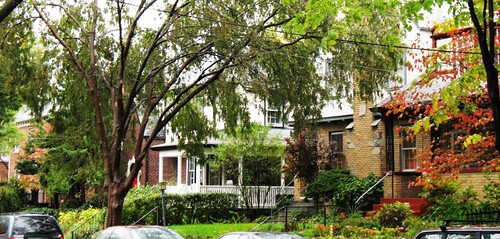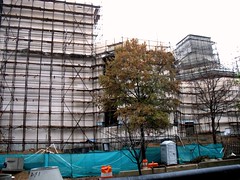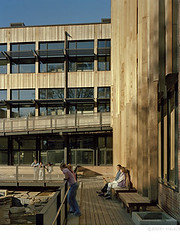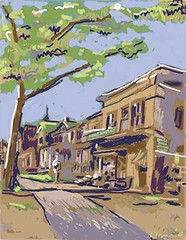Architecture matters

Posted October 25, 2007 at 9:55PM
 My spouse and I live in a pretty, 1920s neighborhood in Washington. One of the many nice things about this is its location less than half a mile to the Metro, DC’s subway system. Actually, we’re in between two Metro stations, the other being just slightly more than half a mile away. Which one I use depends on circumstances.
My spouse and I live in a pretty, 1920s neighborhood in Washington. One of the many nice things about this is its location less than half a mile to the Metro, DC’s subway system. Actually, we’re in between two Metro stations, the other being just slightly more than half a mile away. Which one I use depends on circumstances.
In between our home and the station I generally use in the mornings, I walk through an area with some embassies (this is Washington, after all) and the concrete campus of the University of the District of Columbia. This is the unpleasant part of the walk.
 UDC is a worthy institution, providing an education to many good kids who want to improve their lives. But the experience it offers to both its students and the neighborhood is seriously compromised by awful architecture – just the worst sort of mind-numbing, featureless,1970s big concrete boxes placed around a barren concrete “plaza” with no grass, no shade trees, no color, and no outdoor public gathering places that anyone would actually like to gather in. It doesn’t help that maintenance budgets have been tight, some of the concrete is showing cracks, some of the few plantings are dying, and it’s anybody’s guess whether the building escalators will be working on a given day.
UDC is a worthy institution, providing an education to many good kids who want to improve their lives. But the experience it offers to both its students and the neighborhood is seriously compromised by awful architecture – just the worst sort of mind-numbing, featureless,1970s big concrete boxes placed around a barren concrete “plaza” with no grass, no shade trees, no color, and no outdoor public gathering places that anyone would actually like to gather in. It doesn’t help that maintenance budgets have been tight, some of the concrete is showing cracks, some of the few plantings are dying, and it’s anybody’s guess whether the building escalators will be working on a given day.
Even worse, right across the street from the UDC campus, the massive new Chinese embassy is under construction and nearing completion. Sadly, it looks like it took its architectural inspiration from UDC’s big boxes: its fortress-like concrete walls rise several stories straight up, have few or no windows, and few features of any sort, really.  The building, which will become the largest embassy ever built in Washington, takes up an entire block. Although most of the embassies in our neighborhood are also newish, having been built in the last 10-20 years, for the most part they blend much more gracefully into the landscape and the neighborhood. Why did the Chinese, who certainly hired well-regarded architects (the sons of the truly great I.M. Pei), get it so wrong?
The building, which will become the largest embassy ever built in Washington, takes up an entire block. Although most of the embassies in our neighborhood are also newish, having been built in the last 10-20 years, for the most part they blend much more gracefully into the landscape and the neighborhood. Why did the Chinese, who certainly hired well-regarded architects (the sons of the truly great I.M. Pei), get it so wrong?
I don’t have an answer, though I have some hope that, over time, the starkness of the giant building will soften as landscaping matures and people come and go. For UDC, I can only hope that some benefactor donates a large enough sum of money at least to transform part of the concrete plaza into a lawn, add a terrace café for the students and some walkways, plant some trees, and make some repairs. It actually wouldn’t cost that much, as construction projects go, and it would help a lot in transforming a currently bleak and oppressing environment into one that is more humane and uplifting, not to mention more pleasant to walk through.
Institutional architecture doesn’t have to be this way. Fortunately for me, my morning walk not only begins in a pleasant neighborhood, it finishes in another appealing place: the Metro station itself. Now, Metro has had its own problems with escalators over the years but, once you’re inside the station, you’re surrounded by a large, graceful archway that is at once uplifting and relaxing.  The ample but soft lighting gives the station a warm glow, above harmonious terra-cotta tiles on the platform. If you’re feeling bad here, it’s not the architecture’s fault.
The ample but soft lighting gives the station a warm glow, above harmonious terra-cotta tiles on the platform. If you’re feeling bad here, it’s not the architecture’s fault.
And I would submit that Metro’s inspirational yet inviting architecture is one of the reasons people feel comfortable with Washington’s mass transit stations and have made it the second most successful system in the country. As a result, the environment benefits greatly. (New York’s subway system, the nation’s most heavily used, succeeds in spite of its dreary architecture, not because of it; but that’s a story for another day.)
There’s also another new institutional building in our area, just a few blocks in another direction from our house, that makes a much better neighbor than does UDC or the new Chinese embassy. And, like Metro, it’s also an example of what we can build to help rather than hurt the environment: it’s the new middle school building for the Sidwell Friends School, which has earned the US Green Building Council’s highest “platinum” award for its environmentally friendly features.
 Actually an addition and major renovation that more than doubles the size of a pre-existing structure, Sidwell’s building is still nowhere near the scale of the Chinese embassy. That’s part of the point – while much larger than our neighborhood’s nearby houses, it is not so ridiculously overscaled that it insults everyone who lives or works nearby. What you notice about its exterior isn’t overwhelming, featureless concrete, but slats of wood made from recycled wine barrels, along with abundant windows. On one side are the beginnings of a terraced garden that will grow beautiful over time while providing a stormwater capture and recycling system. On the other is my street, just four blocks from our house. The building will use 60 percent less energy and 70 percent less water than a typical school of the same size, and it’s the kind of place I can take my friends to show them what a state-of-the-art green building can look like.
Actually an addition and major renovation that more than doubles the size of a pre-existing structure, Sidwell’s building is still nowhere near the scale of the Chinese embassy. That’s part of the point – while much larger than our neighborhood’s nearby houses, it is not so ridiculously overscaled that it insults everyone who lives or works nearby. What you notice about its exterior isn’t overwhelming, featureless concrete, but slats of wood made from recycled wine barrels, along with abundant windows. On one side are the beginnings of a terraced garden that will grow beautiful over time while providing a stormwater capture and recycling system. On the other is my street, just four blocks from our house. The building will use 60 percent less energy and 70 percent less water than a typical school of the same size, and it’s the kind of place I can take my friends to show them what a state-of-the-art green building can look like.
I guess the point is that, whether we think about it or not, architecture plays a big role in how we feel about our communities, and also how we treat the environment.  When I come home from work in the evening, I frequently don’t use the same Metro station I used in the morning, but instead I get off one stop farther north on Metro’s red line. Now this is in part because, even though the walk to my house takes a little longer than the morning walk, it’s downhill. That’s a definite plus at the end of a long day. But it’s also more pleasant, taking me past a couple of mid-rise condo and office buildings, and alongside some small restaurants, neighborhood-serving shops, and a church. After a couple of blocks, I’m back in the residential neighborhood, with mature trees, inviting sidewalks, neighbors walking their dogs, and the other sorts of good things that make a place feel like home. The walk takes about ten relaxing minutes. It’s the way it should be.
When I come home from work in the evening, I frequently don’t use the same Metro station I used in the morning, but instead I get off one stop farther north on Metro’s red line. Now this is in part because, even though the walk to my house takes a little longer than the morning walk, it’s downhill. That’s a definite plus at the end of a long day. But it’s also more pleasant, taking me past a couple of mid-rise condo and office buildings, and alongside some small restaurants, neighborhood-serving shops, and a church. After a couple of blocks, I’m back in the residential neighborhood, with mature trees, inviting sidewalks, neighbors walking their dogs, and the other sorts of good things that make a place feel like home. The walk takes about ten relaxing minutes. It’s the way it should be.